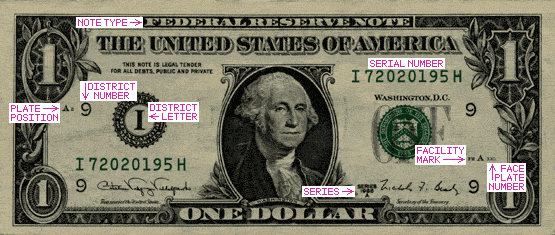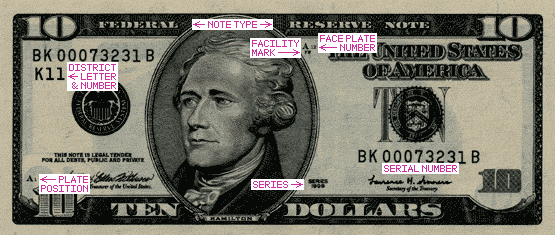These scans illustrate some of the major features of current U.S. banknotes. All of the features highlighted here appear in the same places on all denominations of currency dated up to 1995. The redesigned notes, beginning with Series 1996, still have all the same elements, but in some instances they have been repositioned.


The only note type still produced today is the Federal Reserve Note. Older notes may be of different types; United States Notes and Silver Certificates are the most recently discontinued. For more information, see the page on types of U.S. currency.
Each Federal Reserve Note is issued by one of the twelve Federal Reserve Banks.
That bank's district letter (from A through L) and corresponding
district number (from 1 through 12) appear on each note. The twelve
FRBs and their corresponding designations are:
The series of the note does not necessarily represent the year it was printed. The series changes only when some change is made to the note design. Even then, if the change is considered a minor one, the series date will remain the same, with a letter added after it. For example, the $1 note shown above is from Series 1988A; the only difference between the 1988 and 1988A series is the name of the U.S. Treasurer whose signature appears on the notes. For more information on series dates, see the chronology of series.
The serial number serves to uniquely identify each note within its denomination and series. On Federal Reserve Notes such as those shown above, one letter of the serial number always matches the district letter. On the older notes, this is the first letter of the serial; on the redesigned notes, it is the second letter, since an extra letter was added to the beginning of the serial numbers. The added letter corresponds to the series of the note; all Series 1996 notes have serial numbers beginning with A, and each subsequent series advances the letter by one. For more information on how serials are used on U.S. currency, see the page on serial numbering.
A note's plate position shows where it was located on the original printed sheet. Today, currency is printed in sheets of either 32 notes or 50 notes; years ago, 18-note sheets and 12-note sheets were used. The plate positions on these sheets are labelled as follows:
|
|
|
| ||||||||||||||||||||||||||||||||||||||||||||||||||||||||||||||||||||||||||||||||||||||||||||||||||||||||||||||||||||||||||||||
The face plate number identifies the particular printing plate which was used to print the face side of a note. Similarly, the back plate number (not visible in the above scans) identifies the plate used for the back side of the note. In recent years, the numbering of printing plates has started over from #1 in each new series, so the plate numbers rarely get higher than a few hundred. Formerly, however, the practice was to number the plates sequentially across many series, so that four-digit plate numbers were not uncommon.
Prior to the recent redesigns, each note had its plate position printed toward the upper left, and its face plate number printed toward the lower right. On the 1996-generation and 2004-generation notes, these elements are located in different places on each denomination, but the plate position is always to the left of the portrait, and the face plate number is always to the right of it--except on the new colorized $100 note, where the two were swapped, apparently for space reasons. In all cases, the larger letter in front of the face plate number is the same as the letter from the plate position. The back plate number is located toward the lower right on all denominations of both the old and new designs. (A few $1 notes printed on an experimental press will have these features arranged differently; see the page on web notes.)
Up until 1991, all U.S. currency was printed at the BEP plant in Washington, DC; but in that year, the new Western Currency Facility was opened in Fort Worth, Texas. Notes printed in Fort Worth will show a small FW facility mark just in front of (or on the 1996-generation $10's, below) the face plate number. Fort Worth notes can also be identified by their back plate numbers, which are printed in larger type than those on notes printed in Washington (the colorized $100 note is again an exception, with the Fort Worth notes for some reason using the Washington-size back plate numbers).